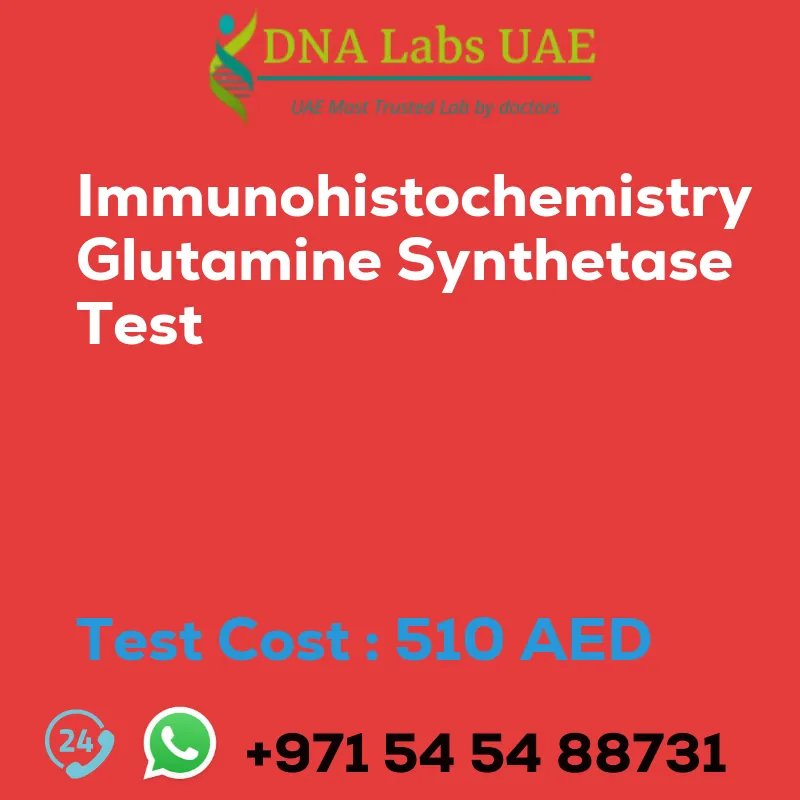IMMUNOHISTOCHEMISTRY GLUTAMINE SYNTHETASE Test
Test Cost: AED 510.0
Symptoms, Diagnosis, and Referring Details:
Test Name: IMMUNOHISTOCHEMISTRY GLUTAMINE SYNTHETASE Test
Components: Price 510.0 AED
Sample Condition: Submit tumor tissue in 10% Formal-saline OR Formalin fixed paraffin embedded block. Ship at room temperature. Provide a copy of the Histopathology report, Site of biopsy and Clinical history.
Report Delivery: Sample Daily by 6 pm; Report Block: 5 days Tissue Biopsy: 5 days Tissue large complex: 7 days
Method: Immunohistochemistry
Test Type: Cancer
Doctor: Oncologist
Test Department: HISTOLOGY
Pre Test Information: Provide a copy of the Histopathology report, Site of biopsy and Clinical history.
Test Details:
Immunohistochemistry (IHC) is a technique used to visualize specific proteins or antigens in tissue sections using antibodies that specifically bind to the target protein. Glutamine synthetase (GS) is an enzyme involved in the synthesis of the amino acid glutamine.
To perform an immunohistochemistry test for glutamine synthetase, the following steps can be followed:
- Tissue Preparation: Tissue samples are collected and fixed in a suitable fixative, such as formalin. The fixed tissues are then embedded in paraffin wax or frozen for sectioning.
- Sectioning: The fixed tissues are sectioned into thin slices using a microtome. The sections are then mounted onto glass slides.
- Deparaffinization (if applicable): If paraffin-embedded sections are used, the slides are deparaffinized by immersing them in xylene or other suitable solvents. This step is skipped for frozen sections.
- Antigen Retrieval: In order to expose the target antigen, heat-induced epitope retrieval or enzymatic digestion methods can be used. This step is essential for formalin-fixed paraffin-embedded (FFPE) tissues.
- Blocking: Non-specific binding sites on the tissue sections are blocked using a blocking buffer, typically containing serum or protein-based solutions.
- Primary Antibody Incubation: The tissue sections are incubated with a primary antibody specific for glutamine synthetase. The primary antibody binds to the target protein in the tissue sections.
- Secondary Antibody Incubation: After washing off unbound primary antibody, a secondary antibody conjugated to a detection molecule, such as a fluorescent dye or an enzyme, is applied. The secondary antibody binds to the primary antibody.
- Visualization: If an enzyme-conjugated secondary antibody is used, a chromogenic substrate is added, which produces a colored precipitate where the target protein is present. If a fluorescent dye-conjugated secondary antibody is used, the sections are directly visualized under a fluorescence microscope.
- Counterstaining (optional): To enhance the contrast and visualization of the tissue sections, a counterstain, such as hematoxylin, may be applied.
- Mounting: The slides are coverslipped using a mounting medium to preserve the stained tissue sections.
After the immunohistochemistry test, the tissue sections can be examined under a microscope to observe the presence and distribution of glutamine synthetase in the tissue. The staining pattern and intensity can provide information about the expression and localization of the protein in the tissue sample.
| Test Name | IMMUNOHISTOCHEMISTRY GLUTAMINE SYNTHETASE Test |
|---|---|
| Components | |
| Price | 510.0 AED |
| Sample Condition | Submit tumor tissue in 10% Formal-saline OR Formalin fixed paraffin embedded block. Ship at room temperature. Provide a copy of the Histopathology report, Site of biopsy and Clinical history. |
| Report Delivery | Sample Daily by 6 pm; Report Block: 5 days Tissue Biopsy: 5 days Tissue large complex : 7 days |
| Method | Immunohistochemistry |
| Test type | Cancer |
| Doctor | Oncologist |
| Test Department: | HISTOLOGY |
| Pre Test Information | Provide a copy of the Histopathology report, Site of biopsy and Clinical history. |
| Test Details |
Immunohistochemistry (IHC) is a technique used to visualize specific proteins or antigens in tissue sections using antibodies that specifically bind to the target protein. Glutamine synthetase (GS) is an enzyme involved in the synthesis of the amino acid glutamine. To perform an immunohistochemistry test for glutamine synthetase, the following steps can be followed: 1. Tissue Preparation: Tissue samples are collected and fixed in a suitable fixative, such as formalin. The fixed tissues are then embedded in paraffin wax or frozen for sectioning. 2. Sectioning: The fixed tissues are sectioned into thin slices using a microtome. The sections are then mounted onto glass slides. 3. Deparaffinization (if applicable): If paraffin-embedded sections are used, the slides are deparaffinized by immersing them in xylene or other suitable solvents. This step is skipped for frozen sections. 4. Antigen Retrieval: In order to expose the target antigen, heat-induced epitope retrieval or enzymatic digestion methods can be used. This step is essential for formalin-fixed paraffin-embedded (FFPE) tissues. 5. Blocking: Non-specific binding sites on the tissue sections are blocked using a blocking buffer, typically containing serum or protein-based solutions. 6. Primary Antibody Incubation: The tissue sections are incubated with a primary antibody specific for glutamine synthetase. The primary antibody binds to the target protein in the tissue sections. 7. Secondary Antibody Incubation: After washing off unbound primary antibody, a secondary antibody conjugated to a detection molecule, such as a fluorescent dye or an enzyme, is applied. The secondary antibody binds to the primary antibody. 8. Visualization: If an enzyme-conjugated secondary antibody is used, a chromogenic substrate is added, which produces a colored precipitate where the target protein is present. If a fluorescent dye-conjugated secondary antibody is used, the sections are directly visualized under a fluorescence microscope. 9. Counterstaining (optional): To enhance the contrast and visualization of the tissue sections, a counterstain, such as hematoxylin, may be applied. 10. Mounting: The slides are coverslipped using a mounting medium to preserve the stained tissue sections. After the immunohistochemistry test, the tissue sections can be examined under a microscope to observe the presence and distribution of glutamine synthetase in the tissue. The staining pattern and intensity can provide information about the expression and localization of the protein in the tissue sample. |








